If you want to learn how to make a fairy garden, look no further. This post breaks down everything you need, including step-by-step directions, as well as lots of fun fairy garden ideas.

I have been spending most of my free time this summer learning more about gardening. I have always wanted to have my own kitchen garden, a beautiful space to grow fruits, vegetables, herbs and flowers. I enlisted my boys to help me with the heavy lifting, but other than that, I have done everything myself.
I am rather proud of my new garden, but boy did I turn my yard inside out. While cleaning up and moving my other pots and plants into their new spaces, I noticed my fairy gardens. Yes, I have several.
I first started making fairy gardens over 10 years ago when my kids were little. It started as a way to get them outside, as well as entertain them and keep them busy during summer break. Over the years, these gardens have been revamped a number of times, but in recent years they have been long ignored.




They certainly have seen better days, but they still make me smile and remind me of my babies when they were, well, younger babies. Since those first gardens were made, I have made many more versions that I have given as gifts to friends and families.
I never seem to run out of fairy garden ideas. I have done beach themes, camping themes, as well as more whimsical and even chaotic gardens (chaos comes with kids).
We have gone from making everything by hand to adding store-bought miniatures. One year, my daughter had a fairy garden birthday and her friends painted their pots and made their own little magical gardens.
My sad and neglected fairy gardens needed my attention. This was a wonderful way to enjoy the San Diego sunshine, continue working in the garden and work with miniatures. I suppose you could say that this post took over 10-years to write!

Tools and supplies needed

This post contains some affiliate links for your convenience (which means if you make a purchase after clicking a link I will earn a small commission but it won’t cost you a penny more)! Read my full disclosure policy.
- Pot: You can use any size pot that you have. You can use shallow or deep pots, large or small. You can also nest an assortment of pots of different sizes or use a broken pot. I have a number of miniature terra cotta pots that I like to accent and use in my fairy gardens, too. You can also use bowls and tea cups, just make sure you have a drainage hole in your planting vessel.
- Dirt: The kind of dirt you need depends on the plants you are using. If you are using succulents, you will need sandy, rocky succulent-cactus soil. For regular plants, you will need potting soil. You can also add mushroom compost or worm castings to regular dirt or garden soil.
- Plants: You can use any kind of mini plants that you can grow in your area. I go into further details on the plant options you can use below.
- Stones and rocks: I love adding small rocks and stones as accents to the garden. Larger stones also give you structure when you need it, flat river rocks become stairs for multi-level gardens, and fancy crystals or polished rocks can add color and whimsy.
- Sand: If you are adding a mini pathway in your garden or are creating a beach theme, you will need a little sand. This can come from a beach, a playground or construction sand. Sand comes in different textures, colors and sizes from coarse to fine. You can also use pea gravel, tiny aquarium pebbles or horticulture rocks that come in a variety of sizes and colors. Sand and gravel also help define spaces in your garden.
- Miniatures: Well, you are creating a small garden oasis for our fairies, so you need some miniatures to accent your garden. You can add a little or a lot, large or small, store bought or homemade. I usually include one focal pieces plus lots of little accents. I go into more details in the Expert Tips section of this post.
- Shovel: For larger pots and arrangements, you will definitely need a small hand shovel. I also found my mini shovel from my terrarium set to be very helpful for pushing things around and digging small holes in hard to reach places.
- Pruning shears: If you are getting plant samples from your garden, you will need garden shears to snip them. For small bonsai-like trees, you will need to snip and prune your plant to make it fit and look right.
- Other tools: I also found that my long tongs from my terrarium set to be very helpful. I had small plastic containers to hold my various soils, sand and rocks. If you don’t like getting your hands dirty, use garden gloves. I used a paint brush to help clean off the rocks after making a big mess, which was happened way more often that I liked!
- Other accessories: You can decorate and accessorize your fairy garden by using shells, marbles, sea glass, pieces of tile, mini pine cones, acorns, sticks, twine and/or bark.
Plant suggestions
I wish I could give you list of plants that are perfect for a fairy garden and you could just go and get them. But seriously, there isn’t an easy answer here. The plants you can use depends on where you live, the climate you live in, the amount of sun you get and what you have available to you.
I live in San Diego. The climate is mild for the most part, but definitely arid with mild to little rain. Succulents grown very well here, which is lucky for me as they are my favorite plants to use in a fairy garden.

So if you live in a climate like this, too, then I strongly suggest using succulents. You can use any kind of succulent various sizes, from babies to larger varieties. Sedums are smaller succulents that are also great choices. My local Home Depot sells flats of various sedums so you can get lots of choices in one purchase.
You want to choose succulents that aren’t super huge when they are adults. Whatever plants you do choose, you might have to remove the plants when they get too large. This is easy enough for succulents.
If you do have succulents growing in your yard, just snip off what you need and set them aside for a day or two to callous over before replanting. My jade plant is hard to kill and makes a terrific “tree” for your fairy garden.

Some of my favorite succulent varieties include:
- Hens and chicks: These come in a variety of shapes and colors. The mother plant isn’t very large and it sprouts lots of little baby plants.
- Trailing succulents: Use small bits of string of pearls, donkey tail, string of bananas or any number of other trailing type succulents that can hang down from the pot.
- Ice plant: This ground cover plant works well in full sun, are flat and have beautiful brightly colored flowers.
- Echeveria: So many varieties, colors and sizes to choose from in this group!
- Sempervivum: Just like the echeveria, lots of choices to select from.
- Sedum: These are smaller succulents that’s don’t get very tall, but they do fill up a space. Some varieties include coral carpet, black pearl, golden stonecrop and little missy
And the beauty of succulents is that they are super easy to propagate – hence my massive succulent collection! Gently remove a leaf, lay it flat on a pot with moist soil, keep it shaded until babies grow. Most of the time, I pick up the leaves that got knocked off by me, the hose, the kids, my dog and I just toss it back into the pot.
Baby succulents are small and perfect for small spaces in the fairy garden. And if you want more ideas on what to do with baby succulents check out how I used them to make some moss covered succulent eggs (FYI the tutorial is on my food blog, go figure).

Now if you don’t live in an area that is good for succulents, don’t fret. There are other plants you can use. Some options include:
- Irish moss
- Scotch moss
- Creeping thyme
- Micro clover
- Kurapia
- Baby tears
- Super star creeper
- Baby spider plant
- Miniature daisy
- Mini roses
- African violets
- Polka-dot plant
- Gray lavender cotton
- Wood sorrel
- Dwarf umbrella plant
- Money tree
- Dwarf cypress
- Ponytail palm
- Lucky bamboo
- Asparagus fern
- Maidenhair fern

My best tip to picking plants for your fairy garden is to go to a variety of nurseries in your area and look for, you guessed it, small leafed plants with small flowers. Always check out the ground covers available – this is where you can find the mosses.
Remember the location of your fairy garden. Will it get full sun? Partial sun? Full shade? Choose plants accordingly. Small pots dry out quickly, so if your plants need a lot of water, don’t let it dry out for too long. Choose annuals as well as perennials, this way you have something growing in the fairy garden all year long.
And whatever plants you use, they all GROW. So pruning and tending is required to keep everything smallish and manageable.

Step-by-step directions
For these tutorials, I am cleaning up my old neglected fairy gardens. Some of these are 10-years old and needed cleaning up or a total redo. Whether you are making a new fairy garden or fixing an old one, the process is still the same.
1. Fill your pot with dirt. Be sure that the soil you use drains well, but holds its structure. If you have a one-level fairy garden, this is pretty simple. Just scoop and fill ‘er up! If your garden will have levels, you will need to do a little more work.


2. Set up the supports. For multi-level fairy gardens, you need to add a some stability. This varies from garden to garden, depending on your design. In this example, I am showing you the garden I made with a broken pot.
No we didn’t break this pot on purpose. It cracked and broke when we pulled out a massive palm tree that got sick and died. We used the larger broken piece for the middle wall and the small broken pieces to fit in the small gaps.

We first put this together 10 years ago. Over time, the large jade “tree” sank as the dirt slowly seeped out with waterings. I stacked river rocks to fill in the larger gaps, along with a few broken pieces of tile that is now hidden with dirt.
To keep them stable, I used some clay heavy dirt I had found in the yard and wet it to create a glue to secure the rocks in place. When the clay dried my river rock wall held up well.

3. Add stairs. If you are making a multi-level garden, you might want to add stairs. As my old garden had shifted things about over the years, I added some stairs using more flat river rocks.
Once all the supports and stairs were in place, I finished adding the potting soil I was using.
4. Add the plants. This is where the fun begins! I knew that I was going to have a pergola or structure of some sort on top, stairs leading down to the slope area and a little rocky beach at the bottom. Once I figured out the general design, I started adding plants.

For this planter, I chose to use succulents because I have a huge variety of them in my yard I can use. Since I have had this planter for over 10 years, I have tried to grow a variety of plants for that slope area and it has always been tricky.
This time, I decided to use Irish moss for a green lush slope since water would trickle down to this area and I wanted something that would soak it up. I added succulents to the top section and fit smaller plants and trailing succulent for between the rocks.

4. Add pathways. Once all the planting was done, I added the pathways. I used some coarse sand that I had bags on hand for another yard project. This sand was used in the top section where the gazebo will sit and down at the beach area. Simply pour it in and smooth it out, pushing it to the edge of the plants.

5. Add the finish touches. Now you can finish it all up and add any more rocks, miniatures and any other items you want to include. I added some rocks among the succulents to break it up and add interest.
At the very bottom, I knew I wanted a little beach area. Way-back-when I had originally thought I would have actual water in this beach. That didn’t last, even though I lined it with plastic. Dirt and debris would come down the hill and muddy the pond, plus we live in a dry climate so it was always drying out.


I decided to fill the bottom with river rocks and topped it with blue and clear sea glass and marbles that I had stashed in a cupboard. This gives the illusion of water, without having to keep water in there or deal with mosquitos or algae.
I also added mini faux mushrooms to the grass slope, a tiny bunny, a few tortoises (our little nephew is fascinated with tortoises), a bird bath, a garden gnome, a chair, a gazebo and some beach accessories to finish my little wonderland.


Expert tips and FAQs
I am also sharing pictures of a fairy garden I made without succulents. I have no idea what the “tree” is. This planter was a gift from a neighbor who moved away. It sat with me for years and I finally cleaned it and fixed it up for this post.
The plants I used include white alyssum (they also come in purple), purple lobelia crystal palace (I have seen this also in light purple and white), some rosemary cuttings I rooted, thyme, dahlberg daisy and cabaret red calibrachoa.
I also had a lot of sedum gold, so I added that to garden. A non succulent option is Scotch moss, which is a similar bright green color.

Since this garden had a more woodsy feel, I used a grapevine teepee I bought on clearance at Michaels. I could have made it myself, but I wasn’t in the mood. Again, I made homemade structures with my kiddos years ago and I wanted some instant gratification!
Which brings me to my tips on choosing which miniatures work best for fairy gardens. I have used homemade as well as store bought minis that includes wood, popsicle sticks, metal and resin. Which held up best?
Wood. I fixed up a wooden bird house and made it into a pergola. It was painted with acrylics and not really treated with any weathering sealants. Pieces of it eventually fell off, but the thicker pieces held its shape. I am talking 10 years. We have also used those little wooden crate boxes for a surf shack garden that has held up well. Overall, thicker pieces of wood stand the test of time pretty well.

Popsicle sticks. The kids made random things with popsicle sticks. They do warp easily from water, sun and weather changes (as you can see in our homemade surf shack below). These are fun to use and if you don’t mind that they fall apart after a year or two, have fun with them.

Metal. I have used various metal accessories in the garden over the years. Yes, metal corrodes. What a surprise. So yes, metal accessories don’t last in the long haul in fairy gardens. Feel free to use them, but understand they will need to be discarded or replaced.

Resin. I am very surprised with how well my store bought resin accessories lasted. Yes, the colors fade if exposed to sunlight over long periods of time. As you can see below, the teepee is totally faded as well as the guitar in this garden. But in another garden, a little blue Adirondack chair, beach sign and bunny held up very well so I used them again.

If you are making your own miniatures to use outdoors, understand that hot glue connections will fall apart over time. Choose a waterproof glue instead. You can also use twine.
A fun project for your kids to do is to paint rocks. We simply used acrylic paints and painted various designs. I’m partial to mandala dots. We didn’t seal the rocks and they lasted pretty well for several years.

In summary, I suggest using an assortment of miniatures to use in your own garden. Definitely add some homemade elements because, we all know that’s what fairies do. They are resourceful and use found objects, the ultimate recycler!
Some of my favorite places to buy fairy garden miniatures (hint hint, hit the sales at the end of spring and summer):
More importantly, have fun with it! I hope this helps you with your own fairy gardens.
And if you like combining miniatures and gardening, check out how to make mini terrariums.
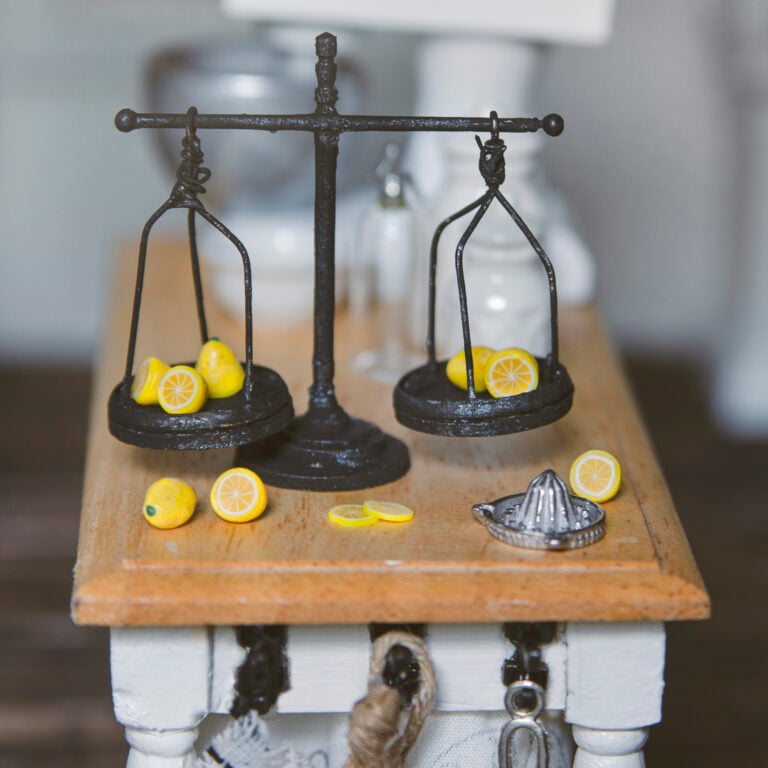
If you are enjoying my blog, why not sign up for my newsletter so you won’t miss out on the mini adventures!
How to Make a Fairy Garden

If you want to learn how to make a fairy garden, look no further. I break down everything you need, including step-by-step directions with lots of pictures.
Materials
- Pot
- Dirt
- Small flowers and plants
- Stones and rocks
- Sand or gravel
- Miniatures
- Other misc. objects like shells, marbles, sea glass, pieces of tile, mini pine cones, acorns, sticks, twine and/or bark
Tools
- Small shovel
- Garden shears
- Garden gloves
- Small rake
- Small paint brush
Instructions
- Fill your pot with soil. Be sure that the soil you use drains well, but holds its structure. If you have a one-level fairy garden, this is pretty simple. Just scoop and fill ‘er up!
- For multi-level fairy gardens, you need to add a some supports. This varies depending on your garden design. In this example, I am showing you the garden I made with a broken pot. I used the larger broken piece for the middle wall and the small broken pieces to fit in the small gaps.
- You can also use some clay heavy dirt and wet it to create a glue to make walls, supports and/or stairs using river rocks.
- Once all the supports and stairs are in place, finish adding the potting soil.
- Add the flowers and plants you want to use. You can also add moss or small plants between the rock wall and stairs.
- Once all the planting is done, use sand or gravel to add the pathways or define a space in the garden. Use a small rake or stick to smooth it out.
- Now add your finishing touches. This can be more rocks, miniatures and any other items you want to include.
Notes
My best tip to picking plants for your fairy garden is to go to a variety of nurseries in your area and look for, you guessed it, small leafed plants with small flowers. Always check out the ground covers available – this is where you can find the mosses.
Choose annuals as well as perennials, this way you have something growing in the fairy garden all year long. And whatever plants you use, they all GROW. So pruning is required to keep everything smallish and manageable.
A fun project for your kids to do is to paint rocks. We simply used acrylic paints and painted various designs. We didn’t seal the rocks and they lasted pretty well for several years.
I suggest using an assortment of miniatures to use in your own garden. Definitely add some homemade elements because, we all know that’s what fairies do. They are resourceful and use found objects, the ultimate recycler!
PS If you try this craft, why not leave a star rating in the direction card right below and/or a review in the comment section further down the page? I always appreciate your feedback.
You can also follow me on Pinterest, Facebook or Instagram. Sign up for my eMail list, too!

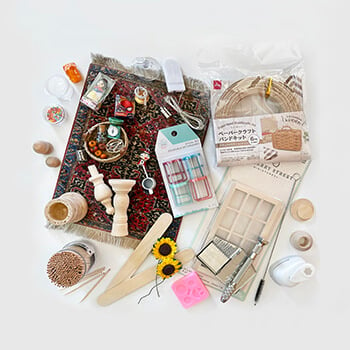


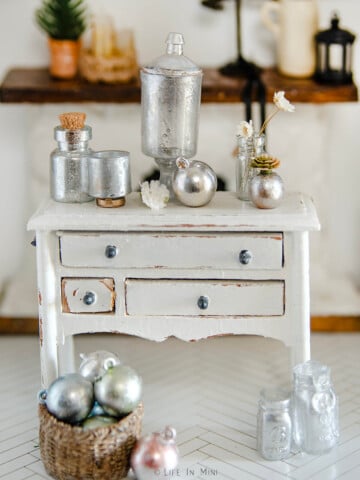
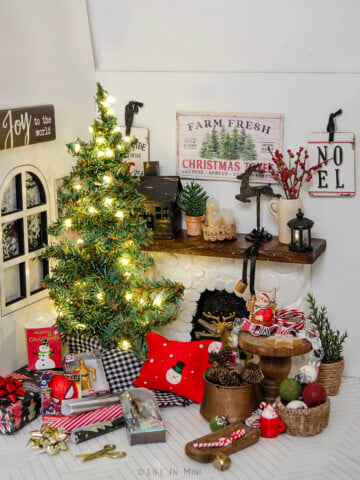
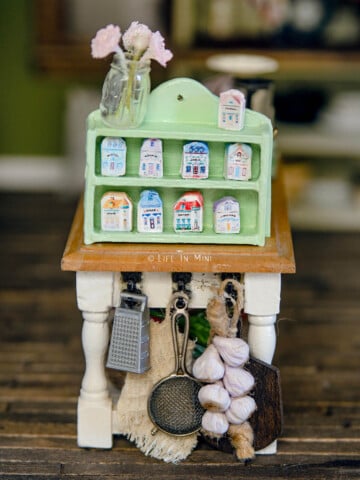
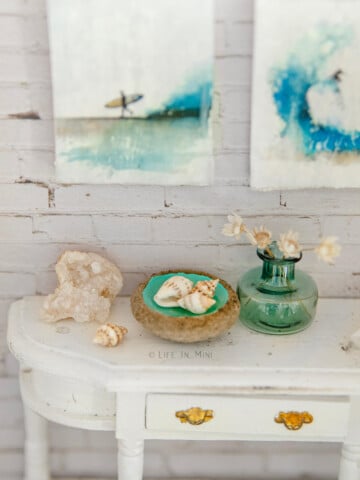
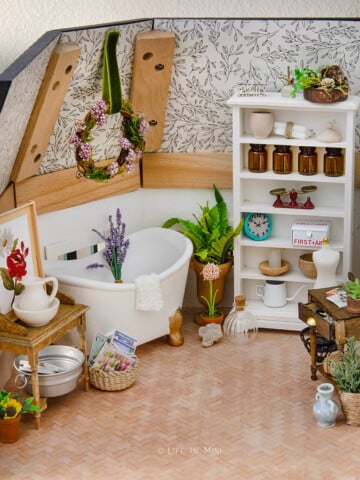
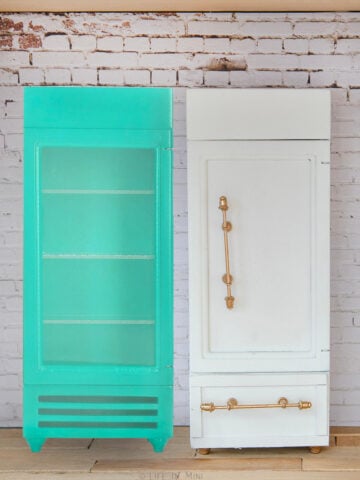
Leave a Reply